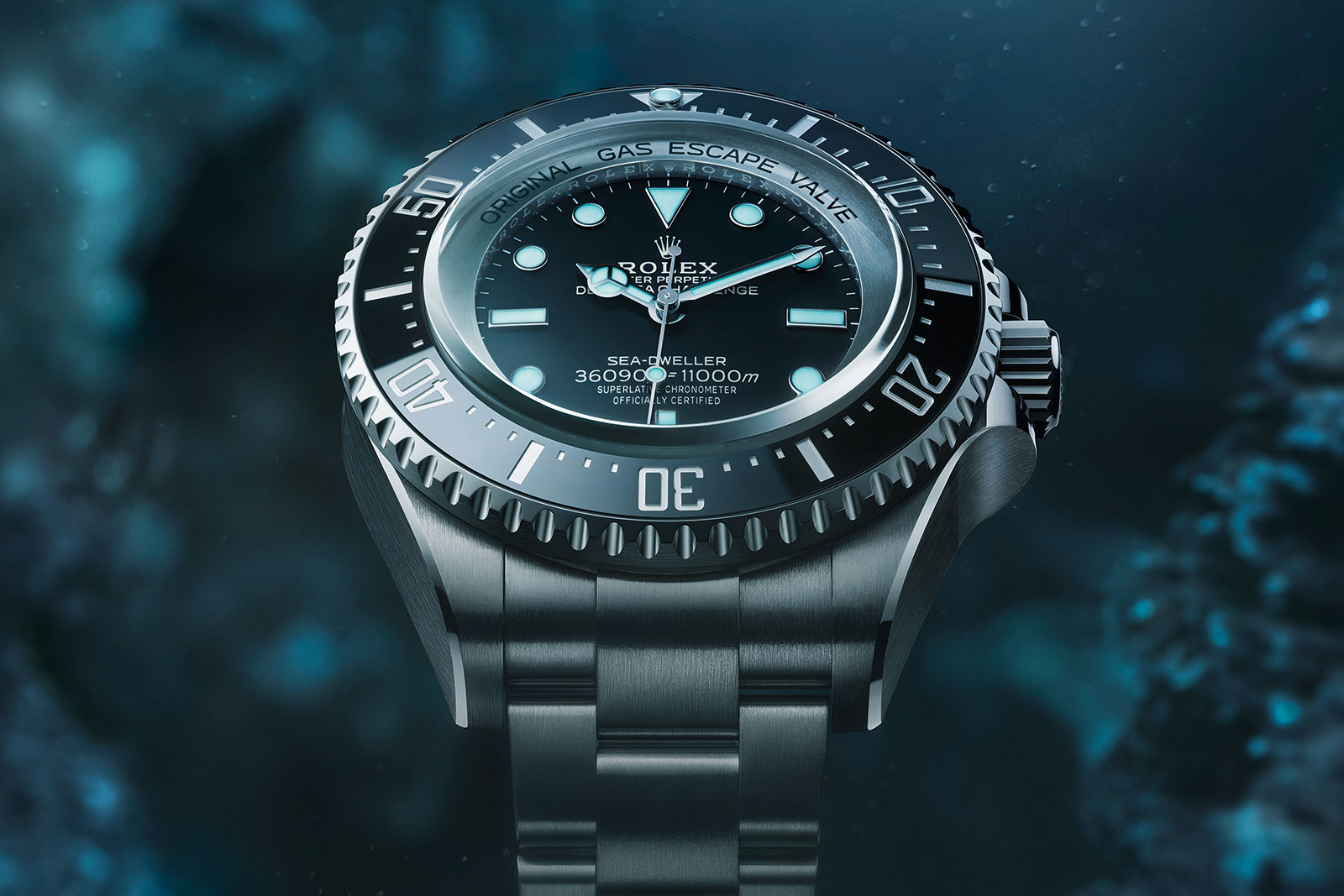Rolex Introduces the Deepsea Challenge Ref. 126067 Rated to 11,000 Metres
The first Rolex in RLX Titanium.
In a surprising off-season debut, Rolex has debuted the record-setting Deepsea Challenge. Evolved from the experimental dive watch of the same name presented in 2012, the Deepsea Challenge is the first serially-produced Rolex wristwatch in titanium. And its rating of 11,000 m, or 36,090 ft, means it clinches the title of the deepest-rated dive watch ever.
Initial thoughts
Conceived as “the ultimate watch of the deep”, the Deepsea Challenge has nevertheless “been crafted with everyday use in mind”. In other words it’s gigantic at 50 mm in diameter and over 20 mm thick, but wearable because both the case and bracelet are titanium, making it relatively lightweight.
It is tempting to imagine Rolex will roll out other titanium watches, though I expect that won’t happen since the use of the alloy for the Deepsea Challenge is primarily for lightness, something less important for conventionally-sized Rolex watches.
As with other Rolex sports watches the technology behind the watch is impressive – in fact the technology within the watch makes it one of the most interesting Rolex sports watches – but it also incorporates details that enthusiasts will appreciate like the chamfered lugs that bring to mind vintage Rolex cases.
In short, it’s a little over the top but extremely cool. It’s somewhat pricey at abut 70% more expensive than the standard Deepsea, but arguably worth it for something that is essentially an experimental watch refined into something wearable.
Rolex’s historical dive watches, including the Deepsea Special (third from left) and next to it, the Deepsea Challenge concept watch
A record-breaker
The original Deepsea Challenge was a concept watch put together in a matter of weeks so that it could accompany filmmaker James Cameron on his expedition to the deepest point on earth, the bottom of the Mariana Trench at 10,912 m (35,800 ft).
Strapped to the outside of Mr Cameron’s submersible, the experimental watch was tested to 15,000 m and naturally survived in the journey in perfect working order. But it was immense at over 51 mm in diameter and almost 30 mm thick.
The production Deepsea Challenge retains the same water resistance – it’s rated to 11,000 m but tested to 13,750 m – but in a more compact case. Both the case and bracelet are made of RLX Titanium, a grade 5 titanium alloy that leaves it 30% lighter than the experimental watch.
The titanium case is first stamped before it is milled and polished
Finished with a matte brushing on most surfaces, the case has a polished bevel along its top edge, a detail reminiscent of vintage Rolex sports watches. According to Rolex, this was done to “highlight the curved profile of the lugs”. Though it was once standard on all Rolex sports watches, the case chamfer is now unique to the Deepsea Challenge.
The secret to the incredible pressure resistance lies within the titanium case, literally. The patented Ringlock system (European patent EP1916576B1) within the titanium case consists of a hardened steel compression ring that surrounds the movement. A flexible titanium case back screws into the base of the ring, while the top of the ring connects to the sapphire crystal.
Both the back and crystal flex slightly inwards under pressure, increasing the force on the gaskets between them and enhancing the sealing of the case. And the steel ring serves protects the movement and dial.
To ensure that the Deepsea Challenge lives up (or down) to its ambitions, Rolex tapped on the expertise of saturation diving specialist Comex (short for Compagnie Maritime d’Expertises) to develop a pressure-testing chamber.
This tank subjects the watch to pressure equivalent to 13,750 m (45,112 ft), or 25% more than the depth rating of 11,000 m in order to provide a margin of safety.
In terms of design the Deepsea Challenge sticks to the typical Rolex design code for dive watches, although the omission of a date is notable. The experimental model had a date, but the Deepsea Challenge does without out, resulting in a clean and symmetrical dial.
Also unusual is the matte, “intense black” dial that contrasts with the glossy finish found on most Rolex sports watches.
As expected for the top-of-the-line Rolex dive watch, the Deepsea Challenge is also kitted out with all of the brand’s bracelet innovations.
The bracelet is also made of RLX Titanium and equipped with a clasp that incorporates the Gridlock ratcheting extension as well as a Fliplock extension link.
And the movement is the cal. 3230, a latest-generation calibre that boasts most of the latest Rolex movement tech including the highly efficient Chronergy going train and skeletonised escapement parts made via lithography.
Key facts and price
Rolex Oyster Perpetual Deepsea Challenge
Ref. 126067
Diameter: 50 mm
Height: Unavailable
Material: RLX Titanium
Crystal: Sapphire, 9.5 mm thick
Water resistance: 11,000 m
Movement: Cal. 3230
Functions: Hours, minutes, and seconds
Winding: Automatic
Frequency: 28,800 vibrations per hour (4 Hz)
Power reserve: 70 hours
Strap: RLX Titanium bracelet with Glidelock extension clasp and Fliplock extension link
Availability: At Rolex retailers
Price: CHF24,800
For more, visit Rolex.com.
Back to top.